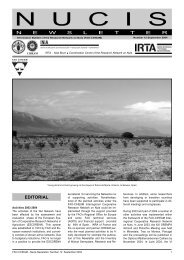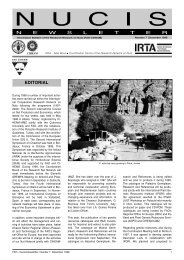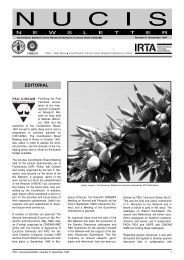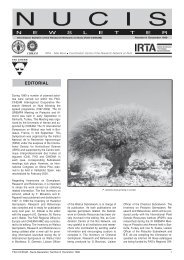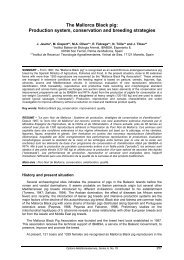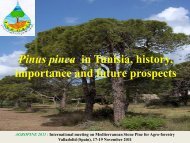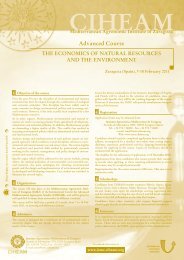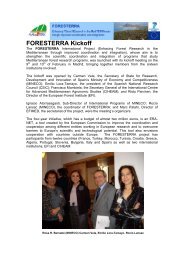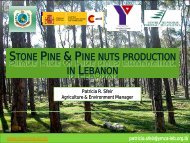NUCIS number 10. December 2001. 48 pages (full ... - IAMZ - ciheam
NUCIS number 10. December 2001. 48 pages (full ... - IAMZ - ciheam
NUCIS number 10. December 2001. 48 pages (full ... - IAMZ - ciheam
You also want an ePaper? Increase the reach of your titles
YUMPU automatically turns print PDFs into web optimized ePapers that Google loves.
experiments partially fulfil Koch’s postulates,<br />
a protocol used by pathologists to determine<br />
the cause of a “new disease”.<br />
This protocol requires the association of<br />
the pathogen with disease, the isolation<br />
of the pathogen in pure culture from diseased<br />
trees, the observation of<br />
symptoms in the inoculated trees and the<br />
isolation of the same pathogen from those<br />
inoculated trees. At present, foliar<br />
symptoms and trunk and limb lesions<br />
have not yet been reproduced in inoculated<br />
trees. More time may be required as<br />
foliar and trunk symptoms are not seen in<br />
the orchard until the trees are at least five<br />
years old.<br />
Figure 4. Internal staining (indicated with arrows) in a section of a branch of a diseased tree<br />
Mapping of symptoms in the orchard<br />
In 1997 and 1998 a mapping kit was developed<br />
as a tool for growers, to allow<br />
them to map the incidence of dieback and<br />
trunk lesions in their own orchards. The<br />
mapping kit consisted of photographs of<br />
disease symptoms along with a method<br />
for assessing the damage based on recording<br />
the <strong>number</strong> of trunk lesions, the<br />
presence or absence of dieback, shoot<br />
death and resinous exudate on each tree.<br />
In case abiotic factors were involved in<br />
the disease, information was also gathered<br />
on the main management factors in<br />
each orchard, including irrigation, fertiliser<br />
regime and rootstock.<br />
Figure 5. Resinous exudate<br />
Role of the bacteria in disease<br />
A suspension of the bacteria was injected<br />
into healthy young pistachio trees in the<br />
glasshouse and the development of<br />
symptoms monitored over 24 months.<br />
Destructive sampling showed that staining<br />
of the xylem occurred in 87% of the<br />
Figure 6. Lesion on the trunk of a diseased tree<br />
inoculated trees and Xanthomonas species<br />
were re-isolated from the stained tissues<br />
of 73% of those trees. Control trees<br />
injected with sterile distilled water developed<br />
limited staining around the injection<br />
point only and Xanthomonas species<br />
were not detected in the tissues. These<br />
The statistical package, Patchy®, used to<br />
study the pattern of spread of disease did<br />
not provide conclusive results about the<br />
pattern of spread of this disease. Mapping<br />
of the symptoms will continue concentrating<br />
on foliar symptoms as well as<br />
on the ones mentioned before, and the<br />
use of other programmes for spatial<br />
analysis will be evaluated.<br />
Control of the disease<br />
A field trial was initiated in 1998 to test<br />
the effectiveness of phosphorous acid<br />
(mono-di potassium phosphite) and Bion<br />
(acibenzolar-S-methyl) in controlling the<br />
disease. Neither of the treatments alleviated<br />
disease symptoms.<br />
CURRENT RESEARCH:<br />
The aims of the current project are:<br />
• Determine the bacterial pathovars associated<br />
with pistachio dieback.<br />
The bacteria consistently associated with<br />
the disease have been identified as Xanthomonas<br />
translucens by various means<br />
and have been sent to taxonomists with<br />
expertise in Xanthomonas species (University<br />
of Gent, Belgium) for confirmation.<br />
Once results are available, inoculation of<br />
various hosts to identify pathovar(s) and<br />
confirm pathogenicity will be conducted.<br />
• Develop protocols for detection and<br />
recognition of pistachio dieback.<br />
Isolation from twigs and culture on SPA<br />
has proved successful. Isolation from<br />
30 FAO-CIHEAM - Nucis-Newsletter, Number 10 <strong>December</strong> 2001



